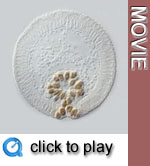Gastrulation
|
It is not birth, marriage
or death,
but gastrulation, which is truly the most important time in your life. Lewis Wolpert (1986) |
Gastrulation leads to the formation of the three germ layers - ectoderm, endoderm and mesoderm. The separation of the three germ layers is achieved by means of the invagination of the presumptive mesoderm, the anterior and posterior midgut primordia and the hindgut anlagen. After invagination, these anlagen remain organized as a tube and share a common lumen. One important consequence of gastrulation is that large areas of the blastoderm become topologically distinct. The withdrawal of 1250 cells from the surface of the blastoderm, brought about by ventral furrow formation and amnioproctodeal invagination, leads to the separation of mesodermal a
 nd
endodermal anlagen from the ectodermal anlage, and from this stage onwards
the cellular behaviour of the three germ layers is conspicuously different.
nd
endodermal anlagen from the ectodermal anlage, and from this stage onwards
the cellular behaviour of the three germ layers is conspicuously different.
Invagination
of the ventral furrow is initiated by apical constrictions of cells located
in the middle of the mesodermal anlage (ventral plate). As the cells also
flatten, the blastoderm nuclei become displaced basally, probably being
pushed by the cytoplasm as consequence of a slight shortening of the cells.
Invagination of the cells forming the endodermal
anterior midgut occurs slightly later than that of the ventral furrow, and
the invaginating cells undergo shape changes similar to those described
above for the ventral furrow. The invagination of the amnioproctodeum starts
at the beginnig of germ band elongation with a dorsal displacement of a
plate of cells at the posterior pole of the embryo. The original tubular
architecture of the mesoderm primordium in the ventral furrow is lost at
the onset of mitotic activity, when the cells dissociate to divide. They
loose their epithelial character and form an irregular mesenchym. This disaggregated
appearance of mesodermal cells persists during the fast phase of germ band
elongation (first and second mesodermal mitoses). Extensive mixing of mesodermal
cells does not seem to occur during early germ band elongation neither in
the anteroposterior nor in the lateromedial dimension. On the contrary,
it appears that the mesodermal cells retain the same topological relationships
with the overlying ectodermal cells that their anlage had in the blastoderm.
Media list
Genes discussed
|
Gene
|
Gene product - Domains
|
Function
|
Links
|
|
twist (twi)
|
transcription factor - bHLH
|
required for mesoderm development, high Twi levels
block formation of visceral mesoderm and heart and induce somatic
myogenesis
|